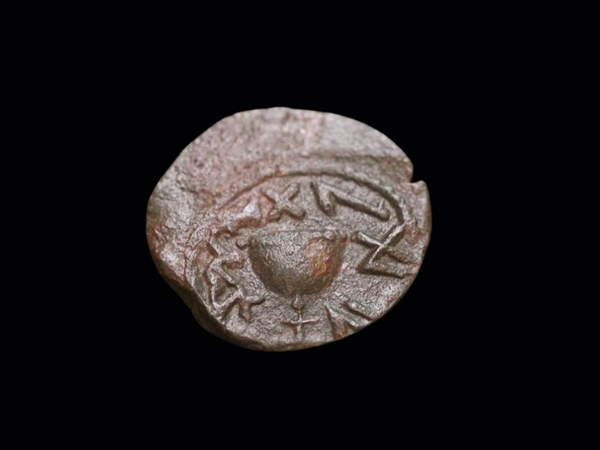A rare bronze coin, dating back more than 1,950 years, was recently unearthed during ongoing archaeological excavations at the Jerusalem Archaeological Garden-Davidson Center. The exceptionally rare find dates back to the fourth year of the Great Jewish Revolt against the Roman Empire, A.D. 69, exactly one year before the destruction of the Second Temple in 70. Making the find even more significant is the inscription engraved in ancient Hebrew alphabet on the coin’s obverse: “For the Redemption of Zion.” A powerful formula, a summary of the collective feeling of the Jewish people in those dramatic years, when the rebellion against Roman rule had by then reached its peak and the fate of the holy city was becoming increasingly uncertain.
The find took place near the southwestern corner of the Temple Mount, a particularly archaeologically and religiously sensitive area that has already been the scene of important discoveries in the past. The intervention is part of the sixth excavation campaign conducted under the direction of archaeologists Yuval Baruch, Filip Vukosavović and Esther Rakow-Mellet, on behalf of theIsrael Antiquities Authority, in cooperation with the City of David and the Society for the Reconstruction and Development of the Jewish Quarter. This is a find that confirms the control exercised by Jewish rebels over the city until the final stages of the conflict. The ability to mint its own coinage, during a period of high wartime and political tension, indicates the presence of organized structures and a leadership determined to keep alive the institutions, including symbolic ones, of a nation under siege.

Esther Rakow-Mellet, archaeologist at the Israel Antiquities Authority, says, “In the last few days we received an unexpected gift: Yaniv David Levy, our numismatics expert, found a coin covered with soil. Even then we suspected that it might be a rare specimen. We eagerly welcomed its return from the laboratory, and it turned out to be a genuine greeting from the Jewish rebels of the fourth year of the Great Revolt.”
Yaniv David Levy, researcher and curator in the numismatic department of the Israel Antiquities Authority, explains, "The coin is bronze and in good condition. The obverse shows a chalice and, around it, the inscription in ancient Hebrew ’LeGe’ulat Zion’ - ’For the Redemption of Zion.’ The reverse depicts a lulav (palm branch used during the festival of Sukkot) and two etrogs (cedars). The reverse bears the inscription ’Year Four,’ which indicates the fourth year since the revolt and allows us to date the coin between the Hebrew month of Nissan (March-April) in 69 CE and the month of Adar (February-March) in 70. These coins differ from those of earlier years in larger size and weight, and in the replacement of the inscription ’For the Freedom (Herut) of Zion’ with ’For the Redemption of Zion.’"
According to scholars, the fourth-year coins were probably minted in Jerusalem under the leadership of Shimon Bar Giora , one of the main commanders of the final phase of the revolt. They are considered relatively rare because of the rebels’ logistical and production difficulties toward the end of the conflict. Most of these coins were found in or near Jerusalem.
The excavations, which continue to return exceptionally valuable materials and architecture, are supported financially by the Shalem Project and the City of David Foundation, entities committed to enhancing Jewish archaeological heritage and promoting historical research in Israel. The ancient coin will be on public display for the first time during summer tours at the Jay and Jeanie Schottenstein National Campus for Israel Archaeology in Jerusalem. The occasion will offer visitors a chance to take a close look at a unique object, laden with religious and historical significance, that contributes greatly to the understanding of the final years of the Second Temple and Jewish resistance against Rome.
The find is also part of the commemorations associated with Tisha B’Av, a Jewish day of mourning dedicated to the destruction of the First and Second Temples. In fact, on Saturday, August 8, the annual “How Stones Shatter” event will be held in the City of David, organized precisely to coincide with this anniversary. The program includes a public reading of the Scroll of Lamentations, which will take place alongside the remains described in the text, thus offering a direct link between the biblical past and contemporary collective memory.
The director of the excavations on behalf of the Israel Antiquities Authority, Yuval Baruch, who has been studying this site for more than 25 years, comments, “The inscription ’For the Redemption of Zion,’ which replaces the earlier ’For the Freedom of Zion,’ signals a profound change in the identity and mood of the rebels. Approximately six months after the fall of Jerusalem on the 9th of Av (Tisha B’Av, August 70 A.D.), the spirit shifted from euphoria to hope for a miracle, through the symbolism of the ’four species’ (lulav and etrog) used to evoke the festival of Sukkot and pilgrimages to the Temple.”
Concludes Esther Rakow-Mellet: “Two thousand years after its coinage, we find this moving testimony just days after Tisha B’Av. I don’t think there is a more powerful symbol than this.”
 |
| Jerusalem, rare Jewish coin discovered dating back to the eve of the fall of the Second Temple |
Warning: the translation into English of the original Italian article was created using automatic tools. We undertake to review all articles, but we do not guarantee the total absence of inaccuracies in the translation due to the program. You can find the original by clicking on the ITA button. If you find any mistake,please contact us.